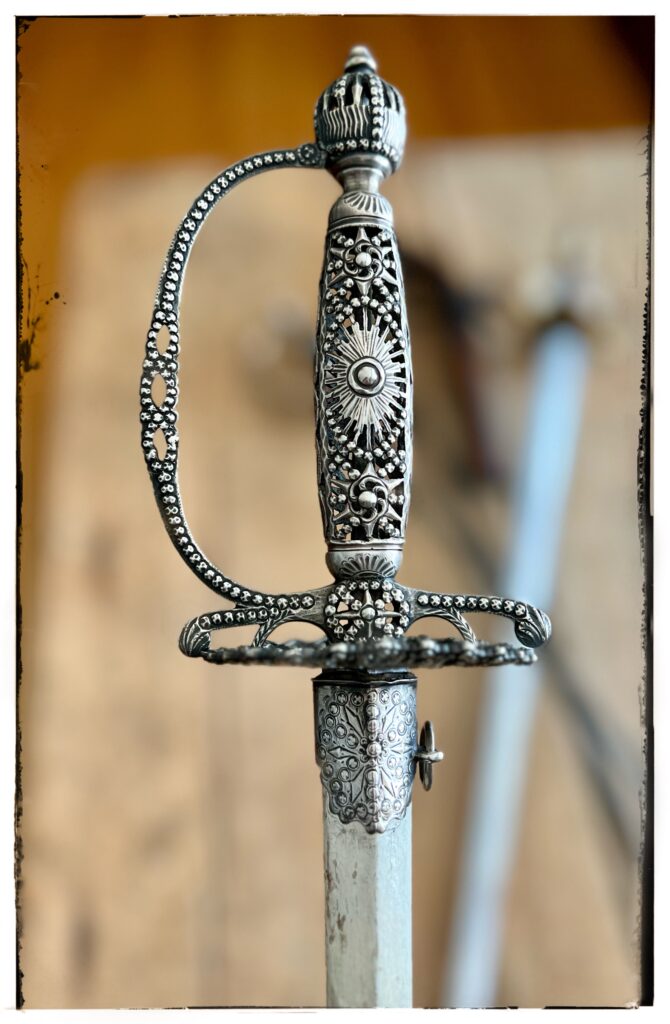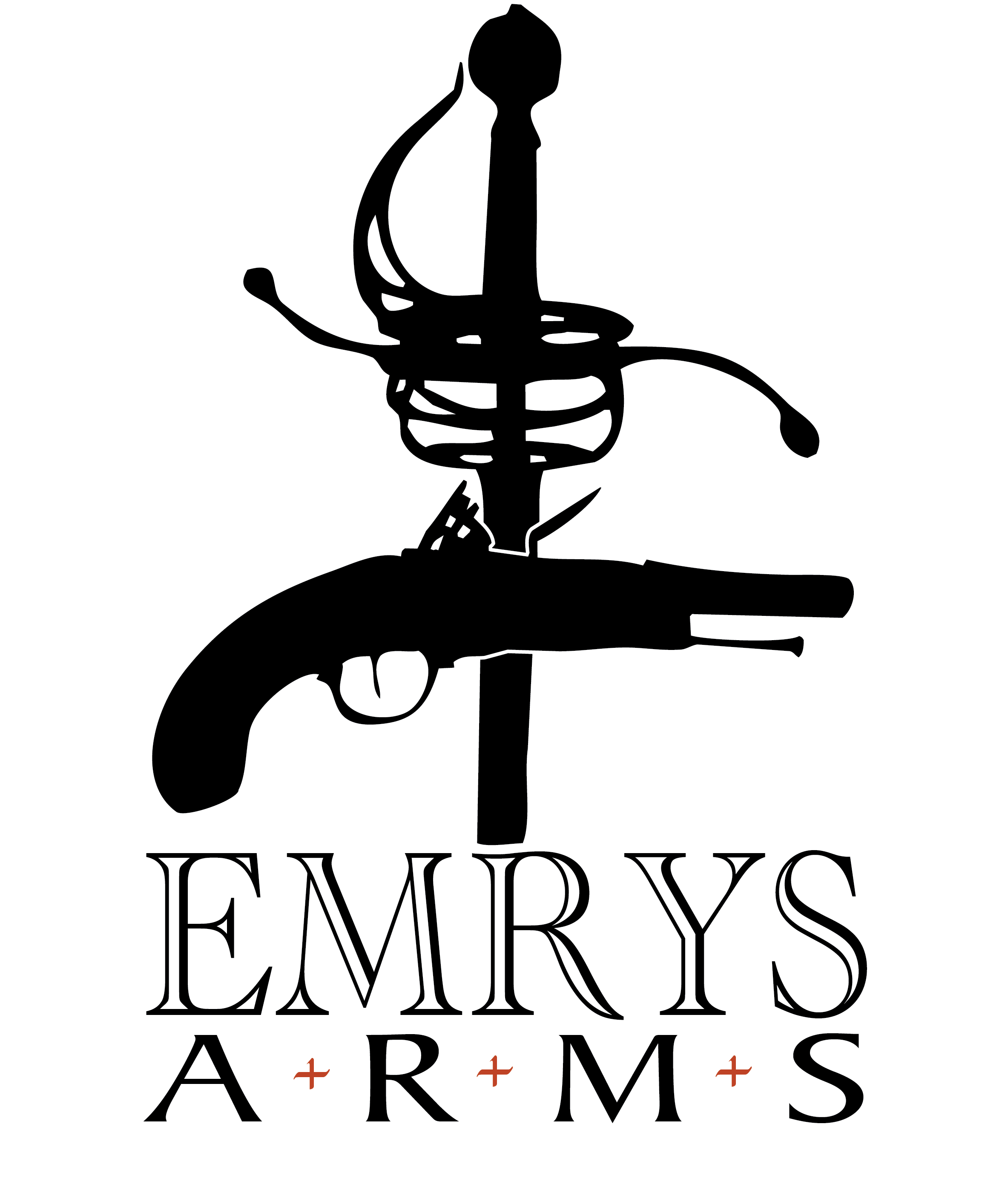| Collection #: | 2024.002 |
|---|---|
| Type: | Smallsword |
| Nationality: | English |
| Pattern: | N/A |
| Date: | 1768-1790 (specifically 1782/83) |
| Hilt Style: | Pierced and Silver beaded D hilt |
| Blade Length: | 78.6cm (30.94") |
| Blade Width: | 2.1cm (.83") |
| Overall Length: | 104cm (40.94") in scabbard 96cm (37.8") sword alone |
| Maker (Assembler): | Thomas Langford - 50 Fleet Street - London - marked on rear of scabbard locket |
| Maker (Hilt): | William Kinman - date marking for May 1782 - May 1783 - hallmark on guard |
| Blade Markings: | Various floral and checkered patterns, possibly a crest split over the tri-foil blade and possibly a small stand of arms, an operatic type lady who seems to be singing or orating with one arm raised. |
| Weight: | 406g with scabbard / 325g sword alone |

This elegant late 18th-century English smallsword exemplifies the artistry and refinement of ceremonial weaponry during the Georgian era. Crafted entirely from silver, the hilt features a harmonious blend of intricate openwork, engraved detailing, and decorative motifs, showcasing the extraordinary skill of the silversmith. Each element of the hilt serves as both a functional and ornamental component, contributing to the sword’s overall splendour and status as a symbol of distinction. The sturdy trefoil blade would have ensured that this piece, while very decorative, was also very functional.
The pommel is a striking feature, designed in a spherical, openwork cage style. Composed of vertical and diagonal silver bars, it creates an airy, architectural effect that allows light to pass through. The bars are adorned with raised bead-like details, giving the appearance of inset diamonds, which add a sense of texture and richness to the design. A series of decorative bands encircle the base and apex of the pommel, providing structural definition and reinforcing its symmetry. The topmost element is a domed finial, polished to a shine, which crowns the pommel with understated elegance.
The grip continues the openwork theme, with an elaborate arrangement of floral and star-like motifs intricately carved into the silver. A central radiant sunburst design dominates the grip, its rays encircling a raised, polished central element, symbolizing celestial or noble themes. The balance of floral shapes, symmetrical stars, and tactile texture creates visual and physical interest. The grip is framed at the top and bottom by solid silver bands, ensuring both durability and aesthetic cohesion. Over time, the silver has acquired a gentle patina, adding depth and highlighting the craftsmanship.
The knuckleguard extends gracefully from the pommel to the dish guard, with a curved structure that provides protection while enhancing the sword’s visual flow. Its openwork design features a repeating series of small, raised bead-like elements, arranged to resemble inset diamonds. These details mirror the decorative texture found in the pommel and lend a cohesive, jewel-like quality to the hilt. The central portion of the knuckleguard is marked by three consecutive oval piercings, which add symmetry and reinforce the sense of delicacy in its design. The edges are smooth and polished, offering both comfort in handling and a refined finish. The interplay of open space and raised decoration imbues the knuckleguard with a sense of elegance and sophistication.
There are several examples in various museums which have very similar pommels and knuckleguards.
The dish hilt guard is a true centerpiece of the sword’s design, combining intricate openwork with finely engraved details. Its outer edge is adorned with a lace-like pattern of repeating floral and bead-like elements, contributing to its light and airy aesthetic. Toward the center, engraved scrollwork adds an elegant, flowing quality, typical of late 18th-century decorative styles. The guard’s central feature is a radiant design encircling the base of the blade, symbolizing order and symmetry. Polished silver highlights catch the light, while a subtle patina enhances the intricate patterns, adding contrast and depth.
The blade is as refined as the hilt, featuring a trefoil design, meaning it has three hollow-ground edges that extend gracefully to the tip. This construction not only provides structural strength but also complements the sword’s elegant proportions.
On the left-hand side of the blade (when held straight in front of you), the engraving begins near the hilt with a checkered box containing foliage. This motif is followed by an intricate foliage display, leading to a depiction of what appears to be an opera singer with one hand raised, suggesting a connection to performance or culture(?). The decoration concludes with another foliage design, which extends to about the first third of the blade.
The right-hand side of the blade features an engraving that is bisected by the third edge of the blade, adding a sense of symmetry and depth. It starts with the same checkered box and foliage design, continuing to a foliage motif that possibly surrounds a shield. Further down, there seems to be a depiction of a “stand of arms,” including flags and spears, a traditional symbol of military strength or allegiance. The engraving finishes with a final foliage display at the end of the first third of the blade.
The scabbard is crafted from white-coloured vellum and is embellished with silver fittings that echo the decorative motifs found on the hilt.
The top locket, made of silver, is marked with the sword maker’s name and address, inscribed in a decorative script as “Langford, 50 Fleet Street.” This locket features a star-shaped design, mirroring the star motifs on the hilt. The star is surrounded by punched circular details that extend between its rays and into its centre. On the front-facing side of the scabbard, the locket’s edge sweeps decoratively downward to meet the fold created by the blade’s raised third edge. The back edge of the locket is cut straight across.
The middle band, also silver, is decorated with a foliage-like design on all three sides. Its edges mimic the wavy lines of the locket, maintaining a consistent theme.
The chape is finished with an undulating edge around all three sides. Below this, two incised lines encircle the chape, which then extends smoothly to a steel terminal ball at the tip, offering a subtle contrast in materials.
The sword was made (assembled or referred to as mounted) by Thomas Langford (1738-1821), a sword cutler operating from 50 Fleet Street, London, between 1768 and 1791. Langford is listed in various directories primarily as a hatter and sword cutler, with occasional references solely as a sword cutler.
He was elected to numerous positions in the Cutler’s Company over the years but seems to have consistently paid a fine to be excused from serving in the Offices.
The silver hilt was created by William Kinman, a London-based silversmith. He was also a leading member of the Founders’ Company of London and served in all major offices of the guild including Master.
According to the tiny hallmarks tucked away on the pas d’âne ring, the hilt was crafted between May 1782 and May 1783. On the left is the Leopard denoting the London Assay Office and the date letter. The London assay office at this period changed annual dates each May. On the right is the Lion Passant and the initials WK.
Despite being quite a prolific hiltmaker (a lot of examples of his work have been photographed – see the photgraphic reference below), William Kinman declared bankruptcy in 1790.
This late 18th-century silver-hilted smallsword is not merely a weapon but a work of art, reflecting the craftsmanship and aesthetic values of Georgian England. The intricate detailing, symbolic motifs, and exceptional use of silver suggest that this sword was intended for ceremonial or high-status use. The addition of a meticulously engraved trefoil blade, vellum scabbard, and the work of esteemed craftsmen such as William Kinman and Thomas Langford further elevates its status as a masterpiece of functional artistry.
For more information on the Langford family of sword cutlers and the Kinman family of silversmiths, please see the following book:
Langford (Pages 162-163)
Kinman (Pages 159-160)
Additional books with further information on these makers, and small-swords in general:
Hartzler, Daniel D. (2000) Silver mounterd swords – the lattimer family collection. Josten’s Printing Company, State College, Pennsylvania.
Langham, Steve. https://swordresearch.org/SwordSearch/Makers.php (and search Langford or Kinman)
Norman, A.V.B. (1980) The rapier and the small-sword 1460-1820. Arms and Armour Press, London, UK.
Oakeshott, Ewart. (2000) European weapons and armour. from the renaissance to the industrial revolution. The Boydell Press, Woodbridge, Suffolk, UK.
For further visual research, feel free to look up the following books for further examples of work by these makers:
Aylward, J. D.(1960) The small-sword in england. Hutchinson of London, London, UK.
Langford Pictorial Examples: Plates 30 & 30a
Hartzler, Daniel D. (2000) Silver mounterd swords – the lattimer family collection. Josten’s Printing Company, State College, Pennsylvania.
Langford Pictorial Examples: Plate 148
Kinman Pictorial Examples: Plates 107, 137
Norman, A.V.B. (1980) The rapier and the small-sword 1460-1820. Arms and Armour Press, London, UK.
Pictorial Examples: Plates 134, 146 & 150 (150 not labelled as Kinman but the pommel and knuckleguard are identical to this example and the one in the Royal Armouries and pas d’ âne is similar)
North, Anthony. (1982) Victoria & albert museum: european swords. Stemmer House Publishers Inc., Maryland, USA.
Pictorial Example: Plate 49 – colour picture of sword in Plate 150 (Norman), and 50
Southwick, L. (2001) London silver hilted swords: their makers, suppliers and allied traders with directory. Royal Armouries, Leeds, UK.
Kinman Pictorial Examples: Plates 56, 57, 59, 62, 63, 64, 69, 75, 76, 77, 79, 81, 82 and colour plates 4, 6, 8.
Southwick, L. (1982) The price guide to antique edged weapons. Baron Publishing, Woodbridge, Suffolk, UK.
Pictorial Examples: Plates 182, (WK hallmark), 196, 252, 255, 453, 454, 455 These cover a variety of silver hilt types. Plate 455 also lists the sword as being mounted by Langford (name on the scabbard locket), showing that the two must have had a somewhat regular working relationship.
Withers, H. (2006) World swords 1400-1945 – an illustrated price guide for collectors. Studio Jupiter Military Publishing, Sutton Coldfield, UK.
Pictorial Examples: Page 275 shows a sword with an identical pommel and knuckleguard and a similar pas d’ âne. It does not list a maker, but the style is very comparable.
We use cookies to improve your experience on our site. By using our site, you consent to cookies. Enjoy the cookies...they're delicious...
Websites store cookies to enhance functionality and personalise your experience. You can manage your preferences, but blocking some cookies may impact site performance and services.
Essential cookies enable basic functions and are necessary for the proper function of the website.
Statistics cookies collect information anonymously. This information helps us understand how visitors use our website.
Google Analytics is a powerful tool that tracks and analyzes website traffic for informed marketing decisions.
Service URL: policies.google.com

